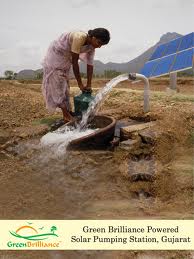India recently launched a hugely ambitious solar powered water pump scheme in which 1.75 million off-grid solar pumps, 1 million grid-connected solar pumps and 10,000 MW of small solar power plants would be distributed in rural areas. This is expected to generate a huge demand for solar panels because if the scheme gets implemented on time by 2022, this would imply a total capacity requirement of 20 GW of solar panels over the next three years.
The KUSUM scheme also stipulates that in order to avail the 30% subsidy for the projects, the solar cells and panels will have to be domestically procured. This has come as a major shot in the arm for the beleaguered solar manufacturers who have been facing the music from cheap Chinese imports for a long time. The safeguard duty which was started on July 2018 at 25% is also expected to end next year, which means the little bit of protection which is there for the Indian solar panel and cell players will also be gone. The safeguard duty has not really led to an increase in solar manufacturing as imports still make up almost 90% of Indian requirements. The domestic players only are able to sell in protected niches which are places where the government gives subsidy and mandate domestic use of components.
In the last one year, imports still constituted $2.2 billion, of which China made up almost 80% with the rest coming from Chinese proxies in SE Asia. The imports from countries like Vietnam, Thailand, etc. went up almost 3-5 times as Chinese companies with bases in those countries used the loophole to export to India from their SE Asian bases. The prices of Chinese solar panels is still cheaper to Indian solar panels even with safeguard duties. While the power minister has stated that he would impose import duties on solar imports going forward, there is no visibility on the quantum or date of those duties. In the absence of this, solar manufacturing capacity has remained stuck over the past years. Now some developers and stakeholders are questioning the government of the mandate to stick to domestic solar cells as the functional capacity is only 3 GW while the demand from KUSUM along could be 5-6 GW if these scheme gets implemented. This means that there will be no capacity to serve the market.
However, solar cell players under the ISMA umbrella are protesting this potential move by the government to relax the domestic mandate and cite the problems that they are facing from imports. These companies have committed that they would increase their capacities substantially if the visibility of demand is given to them.
Google+In a letter written to power minister RK Singh, the Indian Solar Manufacturing Association (Isma) said, in the wake of favorable market visibility stemming from the Kusum scheme, existing manufacturers (Adani Group’s Mundra Solar, Jupiter Solar, Premier Solar, Euro Multivision and Renewsys) have short-term investment plans to set up 2,400 MW of solar cell-making capacity. The current installed cell manufacturing capacity is 3,164 MW. In the letter, reviewed by FE, Isma has requested the government to “maintain the resolve to develop a solar manufacturing base in India, which we are sure will happen in the next 15 to 24 months”. It said the government’s mandate on domestic equipment will increase solar-cell manufacturing base to 8-10 GW by 2021. However, “implementation of the above plans are subject to continued demand visibility/and protection from imports of cells and modules, at dumped prices, from China/Taiwan/Malaysia/ Vietnam and financial closures with Indian banks and institutions”, Isma warned.
Source: Financial Express



